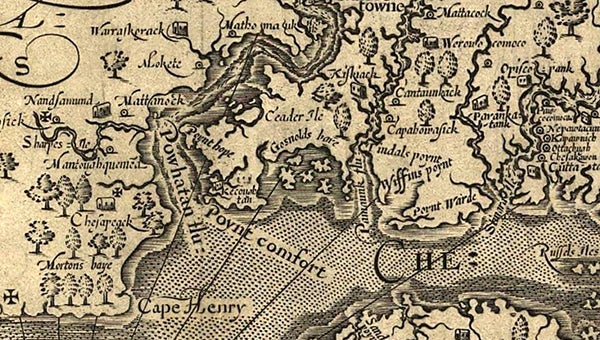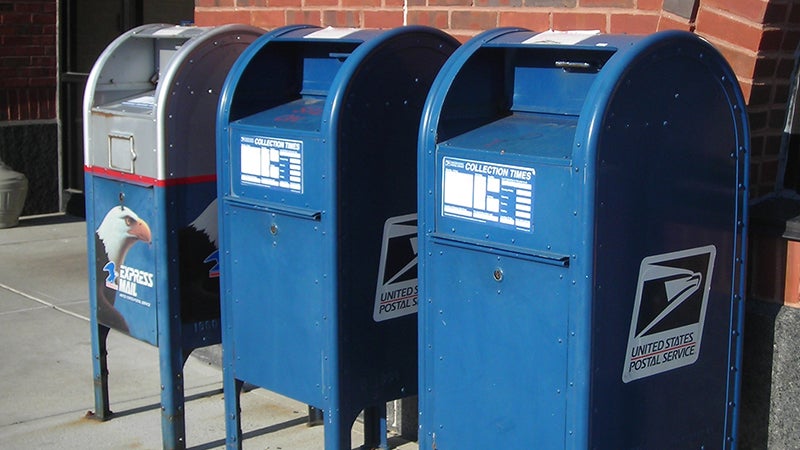Trading with the Nansemonds
Published 7:05 pm Saturday, November 14, 2015

This map is a detail of the map Capt. John Smith made from the information he gathered on his 1608 voyages around the Chesapeake Bay. The “Nandsamund” village and Mattanock Town are near the top left corner. The cross nearby shows where he set up a cross at his farthest point of exploration along the Nansemond River. North is generally to the right, rather than to the top as would be expected. (Submitted Image)
By Kermit Hobbs
Special to the News-Herald
Probably every person who ever went to school in Suffolk knows that in 1608, Capt. John Smith sailed up the Nansemond River and traded with the Nansemond Indians for corn to feed the settlers at Jamestown.
While this story has a pleasing ring to it, the circumstances surrounding it are not quite as idyllic as one might expect. Captain Smith described the incident in his 1624 book, The Generall Historie of Virginia, New-England, and the Summer Iles.
The Jamestown settlement was funded by the Virginia Company, organized by private English investors for the purpose of finding gold in the New World. The Spanish had been very successful in their explorations, and the English expected a rich profit.
The first year of the Jamestown colony had been turbulent, and the colonists had suffered the effects of disease, hunger, conflicts with the natives and infighting among themselves. By early 1608, however, the situation had settled enough so that Captain Smith and a crew of 13 men could sail their “shallop” on a voyage of exploration up and down the Chesapeake Bay. With luck, they might find the gold that their investors so eagerly sought, or better yet, they might find a passage to the western sea.
Smith departed on June 2, 1608, and returned seven weeks later, having made a broad loop around the bay and even followed the Potomac River up to the falls. Three days after their return, Smith sailed out again with a fresh crew of 12 men. This time they turned their attention to other rivers that emptied into the bay.
Smith recalled that on Sept. 6, 1608, the last day before their return to Jamestown, they entered the mouth of a small river, flowing from the south.
“Coasting the shore towards Nandsamund, which is mostly oyster banks … we espied six or seaven salvages (savages) making their wires (fish traps), who presently fled: ashore we went, and where they wrought, we threw divers toyes, and so departed. Farre we were not gone ere they came againe, and began to sing and daunce and recall us; and thus we began our first acquaintance.”
Smith continued to relate how one of the natives managed to convey to him an invitation to come up the river to his home. Surprisingly, the native rode in the boat with them while the others followed along on the shore.
“Seaven or eight myles we sayled up this narrow river; at last on the Western shore we saw large Cornefields, in the midst a little Isle, and in it was abundance of Corne…” Presumably, this “little isle” was what we know as Dumpling Island.
Smith and his crew followed the “salvage” into his house, where they met his wife and children. The Englishmen presented the family “such things as they seeme much contented them” and then left to continue their journey up the river.
Their visit on the island had attracted the attention of many onlookers on the shore, and some “desired us to goe but a little higher to see their houses: here our host left us, the rest rowed by us in a Canow, till we were so far past the Isle the river became very narrow.”
Apparently, at this point the natives landed their canoe and climbed out onto the shore.
“Here we desired some of them to come abord us, whereat pausing a little, they told us they would but fetch their bowes and arrowes and goe all with us, but being ashore and thus armed, they perswaded us to go forward, but we could neither perswade them into their Canow nor into our Boat. This gave us cause to provide for the worst.”
“Presently from each side of the river came arrowes so fast as two or three hundred could shoot them, whereat we returned to get [to] the open [water].” The explorers were then followed by several canoes filled with the “salvages.” “They in the Canowes let fly also as fast, but amongst them we bestowed so many shot, the most of them leaped overboard and swam ashore.”
The volley of fire of the Englishmen’s muskets had broken up the attempted ambush, without injury to any of their men. “Anthony Bagnall was shot in his hat, and another in his sleeve,” wrote Captain Smith.
Smith and his men gathered the drifting canoes and began to cut them to pieces with their axes. When the natives on the shore saw what was happening, they made frantic signals of peace. Their dugout canoes required a great deal of time and effort to build, and they were vital to the natives’ survival.
“Peace we told them we would accept it, would they bring us their Kings bowes and arrowes, with a chayne of pearle; and when we came againe give us four hundred baskets of full Corne, otherwise we would breake all their boats, and burne their houses, and corne, and all they had.”
“They cried for us to do no more, all should be as we would: which presently they performed, away went their bowes and arrowes, and tagge and ragge came with their baskets: so much as we could carry we tooke, and so departing good friends, we returned to James Towne, where we safely arrived the 7. of September, 1608.”
So technically, the story is true. Captain John Smith did trade with the Nansemond Indians in 1608. But it was the Indians’ own canoes that he exchanged for the corn the Jamestown settlers desperately needed.






